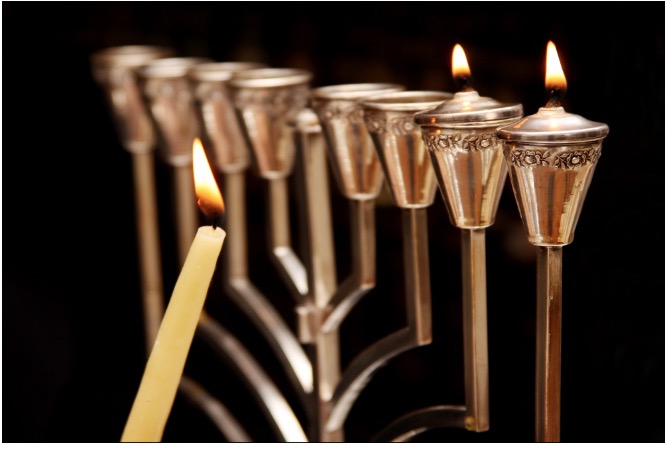Comments
THE VIEW FROM HERE - As the merchandise manager of a large department store in early 20th Century New York, my father claimed to know the true story behind the Chanukkah Menorah. But first a diversion to save Chet.
Chet ( ח - Ch) is the 8th letter in the Hebrew alphabet and the first letter in Chanukkah חנוכה. Hebrew is written from right to left, making ח the first letter and ה (hey H), the last letter in Chanukkah. For no sane reason whatsoever, Chet is being exiled from Chanukkah which is now becoming Hanukkah. This is like saying Merry Hristmas. Some justify this inane change because Americans have trouble pronouncing Chet. The narshkeit behind this justification is multi-fold. (1) Almost all Hebrew letters are hard for English speakers to pronounce, (2) Chet is also spelled Ches since Sephardic Jews pronounce ח as Chet, while Ashkenazi Jews pronounce ח as Ches. Yet, for the last 1,000 years or so, we’ve survived these alternate pronunciations. Furthermore, English speakers also cannot pronounce ה correctly.
Like English, Hebrew words have their root letters. Chanukkah’s root letters are חֲנֻכָּה (chet, nun, kaf, hey), meaning “dedication.” Chanukkah was the re-dedication of the Temple on December 25, 165 BCE, during the Maccabean Revolt, (167-160 BCE) against their Syrian/Greek oppressors. Thus, Chet is extremely important; the combination “hey, nun, kaf, hey” has no meaning.
Thus, changing chet ח to hey ה so that Chanukkah becomes Hanukkah, neither of which Americans can pronounce, is the definition of Narshkeit – foolishness.
The True Explanation of the Nine Prong Chanukkah Menorah
The rededication of the Temple was done by the re-lighting of the Ner Tamid (the eternal light). Only enough oil for one day was found in the Temple’s recesses, but that small amount of oil lasted for eight (8) days while more olive oil was being created. The Ner Tamid lamp is not a menorah. While the seven branched menorah was used in the Temple and has been a symbol of the Jewish people for millennia, it is not an oil lamp. So why is a nine branch menorah used during Chanukkah?
For my dad who was in retail, the transition from lamp oil to menorah candles was obvious.
(1) The fact the lamp stayed lit for eight days was no miracle. All they did was use a short, skinny wick so that en bissel of oil would last eight days. Had the Ner Tamid stayed lit during the entire occupation, my dad claimed, “that would have been a miracle!” (My dad was not a fan of miracles.)
(2) Using an oil lamp to celebrate Chanukkah would have immediately shown that the lamp’s staying lit was no miracle.
(3) “Since we are no fools,” he would relate, ”it did not take long to see the advantage of adopting the seven branch traditional Temple menorah as a nine branch Chanukkah menorah.”
(4) Candles! Yes, candles burn out and one needs more candles. Built-in obsolescence. Yes, a retailer’s dream -- a product which needs quick replacement. On night one, one candle. On night two, two candles, etc. By the eighth night, 36 candles have been used, or “bought in the candle department.” 1+2+3+4+5+6+7+8 = 36 candles.
(5) But wait, there’s more. Each night needs a shamash (שְמַש ) candle. Its purpose is two-fold. First, eight more candles to be bought, so each family needs to buy 44 candles! Second, the shamash is used to light the other candles. While its need is not obvious on nights one and two when a match will do, by night five, you’ll burn your fingers using a match. Thus, as a safety feature, a shamash candle is lit and then it is used to light all the others. At this juncture, my dad said that it was obvious that a Jewish mother had invented the shamash candle for safety, since my mom’s most frequent saying was “Better safe than sorry.” She insisted that safety first was in the Talmud. (Interestingly, anything she ever wanted to me do had its origins in the Talmud, although exactly where was never clear.)
(6) The shamash candle, however, was misnamed. In my dad’s Chanukkah story, the shamash was not a servant but the leader. He called it the Alpha Gadol candle. Later, my mom called it Golda Mier. Today, they would call it Zelenskyy.
(7) My dad had his own version of the significance of the Chanukkah menorah. While Temple’s Ner Tamid symbolized God's eternal and imminent presence, each individual has the same inner spirit for freedom. The menorah shows that while the spirit may temporarily go dark, it reappears the next day stronger than before. Each time that the spirit of human freedom seems dormant, it re-ignites stronger until the light of nine candles is so strong that united together, they have the strength banish the darkness of oppression. For him, Pesach and Chanukkah were Jewish freedom holidays which also symbolized all mankind’s inherent desire for freedom.
Last Wednesday, December 21, 2022, at the darkness of the winter solstice, Ukraine’s President, Volodymyr Zelenskyy, brought to Americans a precious gift during the Chanukkah Christmas season, that is, the opportunity to for us to help keep the universal spirit alive in defiance of Putin’s attempted genocide of the Ukrainian people. Like the US, the Ukraine is a multi-ethnic nation of Christians, Jews, and others. The Ner Tamid and the Chanukkah menorah symbolize God's eternal presence, which exists in each soul. We have a chance to help stop a vile oppressor from extinguishing it in The Ukraine.
(Richard Lee Abrams has been an attorney, a Realtor and community relations consultant as well as a CityWatch contributor. You may email him at [email protected]. The opinions expressed by Mr. Abrams are solely his and not necessarily those of CityWatch.)






